Search results for: 'Rom'
-
 Dreiecksfibel, Bronze (D)
Dreiecksfibel, Bronze (D)Levante, römisch oder älter, 600 v.Chr. Bis 300 n.Chr. 4,2cm lang.
Price: on request Gruppe: 3 Skythische Pfeilspitzen (A-C)
Gruppe: 3 Skythische Pfeilspitzen (A-C)Dreiflüglig, Bronze, ohne Schaft. Typisch für Skythen ab ca. 700 v.Chr. Vermutlich jünger und von Söldnern im römischen Reich. Ca. 15mm bis 25mm.
Price: on request Dreiecksfibel, Bronze (G)
Dreiecksfibel, Bronze (G)Levante, römisch oder älter, 600 v.Chr. Bis 300 n.Chr. 3,5cm lang.
Price: on request 2 Skythische 3-flüglige Pfeilspitzen aus Bronze (AB)
2 Skythische 3-flüglige Pfeilspitzen aus Bronze (AB)Dreiflüglig, Bronze, ohne Schaft. Typisch für Skythen ab ca. 700 v.Chr. Vermutlich jünger und von Söldnern im römischen Reich. Ca. 15mm bis 25mm.
Price: on request 2 Skythische bis römische 3-flüglige Pfeilspitzen aus Bronze
2 Skythische bis römische 3-flüglige Pfeilspitzen aus BronzeDreiflüglig, Bronze, ohne Schaft. Typisch für Skythen ab ca. 700 v.Chr. Vermutlich jünger und von Söldnern im römischen Reich. 41mm, 17mm.
Price: on request Skythische Pfeilspitzen aus Bronze
Skythische Pfeilspitzen aus Bronze2 antike Bronzepfeilspitzen. Dreiflüglig, gute Erhaltung. Typisch für Skythische Völker ab ca. 700 v.Chr. Aus dem danubischen Raum.
Price: on request Sehr schöne skythische Pfeilspitze
Sehr schöne skythische Pfeilspitzeantike Bronzepfeilspitze. Dreiflüglig, sehr gute Erhaltung mit Patina. Typisch für Skythische Völker ab ca. 700 v.Chr.
Price: on request Skythische Pfeilspitzen aus Bronze
Skythische Pfeilspitzen aus Bronze2 antike Bronzepfeilspitzen. Dreiflüglig, sehr gute Erhaltung. Typisch für Skythische Völker ab ca. 700 v.Chr. Aus dem danubischen Raum.
Price: on request 3 Skythische 3-flüglige Pfeilspitzen aus Bronze
3 Skythische 3-flüglige Pfeilspitzen aus BronzeDreiflüglig, Bronze, ohne Schaft. Typisch für Skythen ab ca. 700 v.Chr. Vermutlich jünger und von Söldnern im römischen Reich. 27mm, 18mm und 19mm lang.
Price: on request Keltisch-römische Ringfibel
Keltisch-römische Ringfibel1. Jh. v.Chr. bis 1. Jh. n.Chr., Ende der keltischen Epoche, Beginn der römischen. Hervorragender Zustand, schön patiniert, mit Nadel. Rautenförmiger Querschnitt.
Price: on request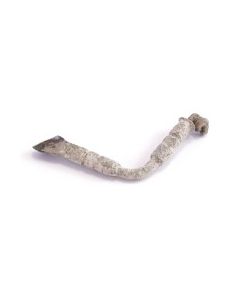 Dreiecksfibel, Bronze (A)
Dreiecksfibel, Bronze (A)Levante, römisch oder älter, 600 v.Chr. Bis 300 n.Chr. 9,6cm lang, sehr groß.
Price: on request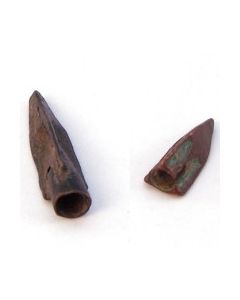 2 Skythische 3-flüglige Pfeilspitzen aus Bronze
2 Skythische 3-flüglige Pfeilspitzen aus BronzeDreiflüglig, Bronze, ohne Schaft. Typisch für Skythen ab ca. 700 v.Chr. Vermutlich jünger und von Söldnern im römischen Reich. 25mm und 16mm lang.
Price: on request 5 Skythische 3-flüglige Pfeilspitzen aus Bronze
5 Skythische 3-flüglige Pfeilspitzen aus BronzeDreiflüglig, Bronze, ohne Schaft. Typisch für Skythen ab ca. 700 v.Chr. Vermutlich jünger und von Söldnern im römischen Reich. 25mm, 23mm, 22mm, 17mm, 25mm.
Price: on request 2 Skythische bis römische 3-flüglige Pfeilspitzen aus Bronze
2 Skythische bis römische 3-flüglige Pfeilspitzen aus BronzeDreiflüglig, Bronze, ohne Schaft. Typisch für Skythen ab ca. 700 v.Chr. Vermutlich jünger und von Söldnern im römischen Reich. 21mm, 37mm.
Price: on request 2 Skythische bis römische 3-flüglige Pfeilspitzen aus Bronze
2 Skythische bis römische 3-flüglige Pfeilspitzen aus BronzeDreiflüglig, Bronze, ohne Schaft. Typisch für Skythen ab ca. 700 v.Chr. Vermutlich jünger und von Söldnern im römischen Reich. 25mm, 39mm.
Price: on request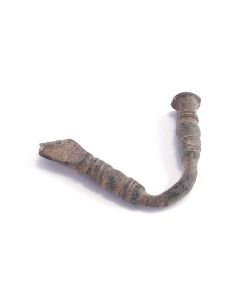 Dreiecksfibel, Bronze (E)
Dreiecksfibel, Bronze (E)Levante, römisch oder älter, 600 v.Chr. Bis 300 n.Chr. 5,5cm x 3,6cm Kastenmaß.
Price: on request 2 Skythische bis römische 3-flüglige Pfeilspitzen aus Bronze
2 Skythische bis römische 3-flüglige Pfeilspitzen aus BronzeDreiflüglig, Bronze, ohne Schaft. Typisch für Skythen ab ca. 700 v.Chr. Vermutlich jünger und von Söldnern im römischen Reich. 23mm, 19mm.
Price: on request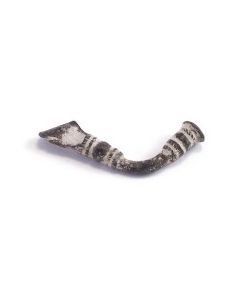 Dreiecksfibel, Bronze (F)
Dreiecksfibel, Bronze (F)Levante, römisch oder älter, 600 v.Chr. Bis 300 n.Chr. 4,5cm lang. 7,5g.
Price: on request Dreiecksfibel, Bronze (B)
Dreiecksfibel, Bronze (B)Levante, römisch oder älter, 600 v.Chr. Bis 300 n.Chr. 7,1cm lang.
Price: on request Gruppe: 5 Skythische Pfeilspitzen (A-E)
Gruppe: 5 Skythische Pfeilspitzen (A-E)Dreiflüglig, Bronze, ohne Schaft. Typisch für Skythen ab ca. 700 v.Chr. Vermutlich jünger und von Söldnern im römischen Reich. Ca. 15mm bis 25mm.
Price: on request Gruppe: 5 Skythische Pfeilspitzen (F-J)
Gruppe: 5 Skythische Pfeilspitzen (F-J)Dreiflüglig, Bronze, ohne Schaft. Typisch für Skythen ab ca. 700 v.Chr. Vermutlich jünger und von Söldnern im römischen Reich. Ca. 15mm bis 25mm.
Price: on request Lekythos from Toledo Museum collection
Lekythos from Toledo Museum collectionEx collection Prof. G. Olcott, the first Columbia University professor for Roman archeology. Acquired from his estate 1912 by the Toledo Museum (Ohio), in the museum collection until 2017. Found in Apulia.
Price: on request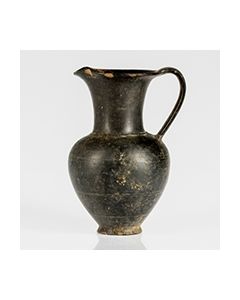 Etruscan bucchero oinochoe from Tarquinia
Etruscan bucchero oinochoe from TarquiniaLarge jar with ovoid body and trefoil mouth. Decorated with carved lines. From an old German collection, acquired in the 1950s.
Price: on request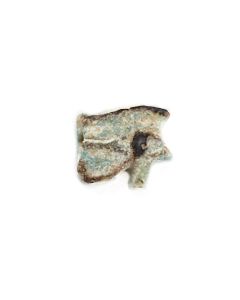 Eye of Horus from the Third Intermediate Period of Egypt
Eye of Horus from the Third Intermediate Period of EgyptSmall amulet in form of the Eye of Horus. Popular type of protective amulet from Ancient Egypt.
Price: on request Juglet from Iron Age II
Juglet from Iron Age IIThis vessel from the Holy Land was made between construction and destruction of the First Temple in Jerusalem. From the well-known Dr. Steve Adler collection.
Price: on request Juglet from Iron Age II
Juglet from Iron Age IIThis vessel from the Holy Land was made between construction and destruction of the First Temple in Jerusalem. From the well-known Dr. Steve Adler collection.
Price: on request Juglet from Iron Age II
Juglet from Iron Age IIThis vessel from the Holy Land was made between construction and destruction of the First Temple in Jerusalem. From the well-known Dr. Steve Adler collection.
Price: on request Melon bracelet from the Hallstatt period
Melon bracelet from the Hallstatt periodThe massive bronze bracelet was found in Mintraching, Germany. The piece is published in an archeological report. Around 600 BC.
Price: on request Horse bit from Luristan
Horse bit from LuristanDelightful artefact attesting the dawn of horse breeding in Western Iran during the 8th century BC. Highly stylized horses form the cheek pieces.
€2,840 Massive bronze lance head from the Near East
Massive bronze lance head from the Near EastFrom the collection of Prof. Ritschel, Salzburg, Austria, president of the local museum association, author of over 50 history books, decorated many times for his achievements.
Price: on request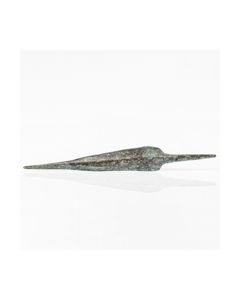 Bronze lance head from the Near East
Bronze lance head from the Near EastFrom the collection of Prof. Ritschel, Salzburg, Austria, president of the local museum association, author of over 50 history books, decorated many times for his achievements.
Price: on request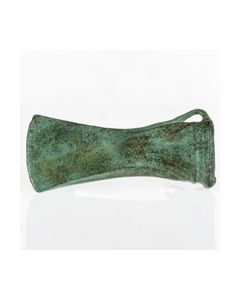 Socketed axe head from Southern Germany
Socketed axe head from Southern GermanyA typical bronze tool of the late Urnfield culture or early Hallstatt culture. It was found near Regensburg in Southern Germany by a voluntary archaeologist.
Price: on request Egyptian heart amulet from a museum collection
Egyptian heart amulet from a museum collectionOne of the most popular Egyptian amulet types. From the collection of the Boston Museum of Fine Arts. Late Period of Ancient Egypt.
Price: on request Cypriot figure from the archaic period
Cypriot figure from the archaic periodThe cylindrical figure is made of light brown clay and dates to the cypro-archaic period. It is referred to as Snowman type in archaeological literature.
Price: on request Large Egyptian sarcophagus mask from Faiyum
Large Egyptian sarcophagus mask from FaiyumImpressive wood relief of an idealized face. Remains of paint. The mask was part of a sarcophagus lid from Ancient Egypt.
Price: on request Dipper juglet from the Holy Land
Dipper juglet from the Holy LandPottery of daily life from biblical times, made around 700 BC. The piece was found in Hebron, a city with considerable historical importance.
Price: on request

